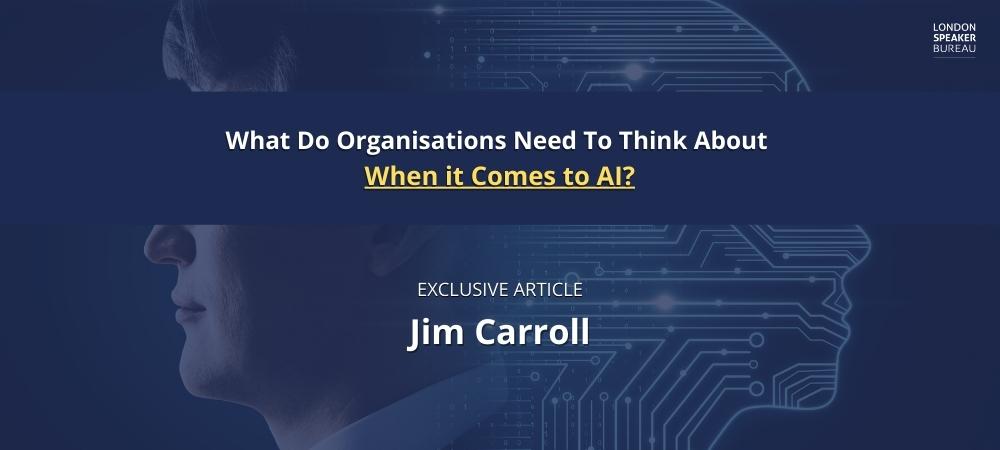In 1993 the World Wide Web burst onto the scene with ferocious intensity.
Within a matter of a decade, new billion-dollar industries emerged, knowledge accelerated, skills and professions forever changed, new competitors caused havoc in every single industry, and the entire issue of public relations and communications was subjected to dramatic new challenges as a result of the arrival of sophisticated misinformation tools. The fact is, entire industries and professions were disrupted – and associations and corporations were subjected to these and other massive changes at a staggering speed
At the time, most CEOs and association executives were ill-prepared for the dramatic emergence of a new technology that would forever reshape their industries and the professions they represented. At the time, I built up a pretty significant presence at corporate and association meetings putting into perspective the strategic and disruptive impact of the Web and other new technologies and trends – and spent the next three decades doing so.
Now we face a similar inflection point with artificial intelligence, but the speed of the disruptive change today is even faster – and it is critical that association executives and CEOs understand not just the technology behind the trend, but the massive disruptive impact that is unfolding.
And if there is one thing I have heard from my clients so far, it is that everyone is absolutely overwhelmed both by the speed of the sudden new AI trends, as well as the impact that these trends represent.
With that in mind, it’s a good time to consider just a few of the different angles from which you need to be thinking about this new era of ‘all AI, all the time!’
First, It’s The Strategy That Matters
“The essence of leadership is finding the strategy within the hype!”
That’s the first comment I offer up to executives trying to make sense of a world of AI that can seem absolutely overwhelming at times.

No doubt you have spent some time working with ChatGPT, have taken a look at Microsoft’s new AI-enabled Bing search engine, and might even have generated a few images with MidJourney or Stable Diffusion. These are the fast-moving new technologies that are quickly taking every association, corporate, government agency, profession, and industry into new and unknown territory. The risk implications seem profound, the knowledge impact pretty intense, and the challenges and opportunities vast.
You can’t help but read or watch the news, consider upcoming annual conferences or events, or have a leadership meeting, and not have a discussion around AI. But so far, much of this coverage has focused – often with breathtaking phrases – the big implications of all these exciting new technologies.
But just as in 1993 and beyond, you don’t need to understand the technology behind a trend to determine your future course of action – you need to understand the strategic implications of the trend. And with that in mind, it’s important not to fall into the trap of FOMO – the ‘fear of missing out’ – and falling into the pit of chasing what the technology industry has long called ‘the latest shiny new toys.’
No doubt new tools like ChatGPT are taking us into a wild and new future, but I’ve long suggested that caution is warranted – because we’d best make sure we understand the strategic implications rather than the technology.
And that’s my first bit of advice – focus on the strategy, not the technology.
No doubt, you’ve got members of your association or organization who are very excited about what new tools like ChatGPT might represent to your future. And yet, we need to ask ourselves – is there a real opportunity here with AI, or is it just this year’s hottest new shiny toy? Here’s one thing I know – the history of leadership is one of having to carefully balance the enthusiasm of their team for chasing hot new trends (such as ChatGPT) with the reality of the need for a real strategic purpose.
Never has this situation become more real than it is today with AI.
Separating Silicon Valley Disruption from Industry Disruption
Second, I think it is helpful to consider that it can be helpful to separate the BIG changes occurring with technology companies with these new AI trends from the changes occurring in your industry, organisation, or profession. One is not necessarily moving at the same speed as the other!
Don’t get me wrong – we are at a transformative moment with the sudden acceleration of AI.
But the first thing is to realize that in the short term, dramatic change is happening with technology companies – but not necessarily with mainstream industries.
I always like to break down any trend into the short-term acceleration of Silicon Valley, technology acceleration – and second, the longer-term disruptive impact on other industries.
 We are seeing massive upheaval with any company or association that is within the tech sector. The next few years will see a seismic battle for dominance between search giants like Google, Microsoft, and Apple; we will also see the birth of new billion-dollar companies, launched from the genesis of a brilliant idea that is being considered at this very moment; we will witness the obliteration of many existing software and service business models.
We are seeing massive upheaval with any company or association that is within the tech sector. The next few years will see a seismic battle for dominance between search giants like Google, Microsoft, and Apple; we will also see the birth of new billion-dollar companies, launched from the genesis of a brilliant idea that is being considered at this very moment; we will witness the obliteration of many existing software and service business models.
After all, right now, there are people in the iconic garage hatching an idea that will make them the next generation’s billionaire superheroes.
And then there is the rest of us. All of us will be impacted by ChatGPT, Stable Diffusion, and Mid-journey, and all the other technology that is in the press these days are massively disruptive – the future of the way we search and interact with information is set to change in massive ways. The search engines we access, the tool at our disposal, and the very nature of the way we work day to day will change. We need to make sure our staff and our members are able to cope with a new era of knowledge upheaval, and this is going to be a complex voyage that we will need to manage.
But we also need to realise that the issues we are faced with are even bigger than that. And that involves the ‘AI Megatrends.‘
The AI Megatrends and Industry / Profession Disruption
That brings me to the third issue – I think it is important to understand that even before ChatGPT burst onto the scene, there was already a lot of AI-based disruption within every single industry for quite some time. I’ve spent years describing various advances of AI in various keynotes in many industries, and have long referred to these as the AI Megatrends.
As a result, you need to look beyond ChatGPT, image and video generation, and the other hot new technologies – and take some time to understand what is already underway. That will help to bring you strategic clarity on what you need to be doing with AI,
 Consider how AI is being used in health care. We already have doctors detecting and diagnosing irregular heart rhythms known as atrial fibrillation, potentially years before they might otherwise have been detected, interpreting signals that are so subtle that humans might not be able to detect them. We are using specialised cameras to examine eyes, combined with AI to detect diabetic retinopathy, which is a leading cause of blindness. We are developing specialised optical technologies that can read physiological data and detect – visually, without body contact – vital signs such as body temperature, pulse, blood pressure, fatigue, and even drug and alcohol use in seconds. We are identifying fake and counterfeit drugs through the examination of chemicals and other markers with AI analysis. We are using AI to improve the accuracy of polyp detection in colonoscopy screening. Then there is what we can call “sophisticated molecular surveillance“—for example, turning cell phones into what some experts call “smell phones” capable of spotting particular medical conditions. Emergency rooms? We’re using AI to help identify and treat patients most at risk in ERs and ICUs: it’s become a sort of early warning system to alert staff to significant but subtle changes in patients that might not be otherwise noticed. We can even use AI to select organs for donor transplant with a greater potential for success of the outcome.
Consider how AI is being used in health care. We already have doctors detecting and diagnosing irregular heart rhythms known as atrial fibrillation, potentially years before they might otherwise have been detected, interpreting signals that are so subtle that humans might not be able to detect them. We are using specialised cameras to examine eyes, combined with AI to detect diabetic retinopathy, which is a leading cause of blindness. We are developing specialised optical technologies that can read physiological data and detect – visually, without body contact – vital signs such as body temperature, pulse, blood pressure, fatigue, and even drug and alcohol use in seconds. We are identifying fake and counterfeit drugs through the examination of chemicals and other markers with AI analysis. We are using AI to improve the accuracy of polyp detection in colonoscopy screening. Then there is what we can call “sophisticated molecular surveillance“—for example, turning cell phones into what some experts call “smell phones” capable of spotting particular medical conditions. Emergency rooms? We’re using AI to help identify and treat patients most at risk in ERs and ICUs: it’s become a sort of early warning system to alert staff to significant but subtle changes in patients that might not be otherwise noticed. We can even use AI to select organs for donor transplant with a greater potential for success of the outcome.
Spin over to agriculture. The idea of precision agriculture has been a part of the industry for close to 30-40 years as a concept; slowly moving at first, it has finally picked up significant speed in the last decade. AI is now moving precision agriculture forward even faster as it allows us to, for example, analyse data from sensors and drones to create precise maps of crops, allowing farmers to optimize irrigation, fertiliser, and pesticide use.
We can fly a drone over a crop and gather very discrete information at a very detailed level – AI can then be used to analyse these images of crops and detect signs of disease or pests, allowing farmers to take action before the problem spreads. And livestock monitoring – for lack of a better phrase, we are in the era of ‘Fitbits for cows,’ using AI-powered sensors that can monitor livestock for health and welfare, allowing farmers to identify and address potential problems before they become serious.
How about insurance with AI?
The industry was already being rapidly disrupted by the use of AI for sophisticated data analytics. The entire concept of AI-based predictive analytics is shifting the industry away from actuarial-based historical assessment of insurance risk to a world of real-time coverage. Policy niches, micro-insurance, and just-in-time insurance are driving an increasing number of new revenue models. Fast-paced trends involving self-driving cars, the sharing economy, personal drones, swarm-bots, smart dust, and augmented reality will either mitigate, accelerate or challenge the very notion of risk assessment and underwriting – and AI plays a role in all of this.
Similar trends are already underway and will continue to accelerate in every single industry, from banking to manufacturing, construction to retail.
And as you read this, keep in mind that while these are massive disruptive trends, it will clearly take some time for the infrastructure, support models, change management, and implementation opportunities some time to evolve. It takes strategic clarity.
Clearly, every single industry, profession, association, and organisation is being significantly impacted by this disruptive change happening within the world of accelerating AI. ChatGPT and LLM technologies have thrown a new spanner into the works, making faster trends that were already well underway. As an executive, you must carefully, clearly, and deliberately approach this disruptive era with a clear strategic goal in mind.
In other words, how do you chase the strategy, not the technology?
Accelerating Risk Issues
Last but not least – and you already know this – the current fast-moving generative AI technologies are presenting all of us with vast new risk issues. I think we need to keep in mind that today – and particularly with these new AI tools – technology has inherently become a risk-manufacturing tool.
What keeps me up at night? When it comes to AI, it fits into my mindset that new technology is evolving so fast that we as a society no longer understand how to manage it and minimise the new risk that it presents. That’s what you need to think about today as a CEO or Association executive. All of these new tools are obviously going to blur the difference between reality and fake to such a degree that we will barely be able to comprehend it.
I’m more concerned about the manner by which it can be used to alter reality, and what is going on right now with these systems, DALL-E, and other text-to-image generators. It’s just exploded in the last three months, it sort of bubbled along there for years and years and years, and all of a sudden it’s… so massively real. What we can do with it is staggering, but what we can do with it from a risk perspective to generate fake headlines or generate video of politicians saying something that they never said, that’s coming at us extremely quickly.
So I worry less about the role of artificial intelligence – you can do magical things, so for example, diagnosis of a disease, AI can do a better diagnosis of 909 different types of eye disease than an ophthalmologist… I’m less concerned about what it provides and more concerned about how it might be used or misused, and I don’t think we as a society are ready at all to deal with that reality.
I think what this means is that as a CEO or association executive, you need to develop a new framework for risk. And you need to do it sooner than you think.
Welcome to our new future. It’s fast, complex, and moving at speed.
 About the author
About the author
Futurist Jim Carroll helps CEOs, senior executives, and association leaders align their strategic objectives to the rapid acceleration of AI. It’s based on customised research specific to your industry and organisation, and aligned to your unique perspective. It’s insight that matters, is relevant, and actionable! None other than NASA has booked him – twice – for a talk on ‘the future of space.
Other clients include the World Bank, Zurich Insurance, Nikon, the BBC, Disney, Pfizer, Chrysler, Volvo, and hundreds more. He is known worldwide for his strategic thinking – and when it comes to AI, you don’t need the tech – you need the strategic insight. You don’t need hype. You need strategic reality. That’s Futurist Jim Carroll.
Interested in booking Jim Carroll as a keynote speaker for your next event?





